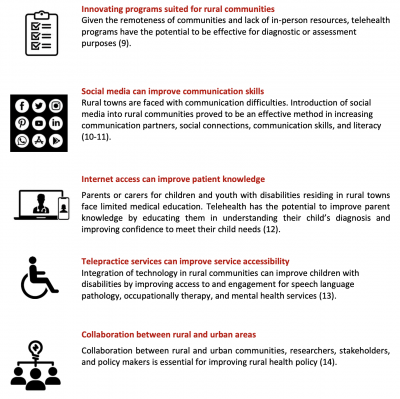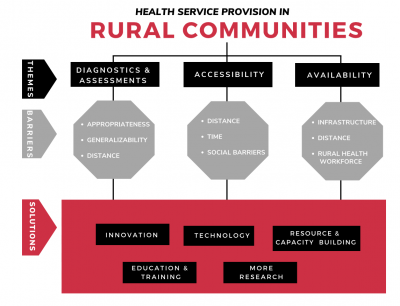Report: Service Provision for Children and Youth with Disabilities in Rural Canada and Australia
Rachpaul CC, Sendanyoye C, Mahling A, Sourial M, & Trto S. (2021). “Report: Service Provision for Children and Youth with Disabilities in Rural Canada and Australia.” Spatial Determinants of Health Lab, Carleton University: Ottawa ON. DOI: 10.22215/sdhlab/2021.2.
A full PDF of this report is also available.
BACKGROUND

Children and youth with disabilities residing in rural and remote regions of Canada and Australia are faced with limited availability and accessibility of appropriate allied health services. As a result, children and families oftenfacing difficulties obtaining a timely diagnosis (1) and experience fewer options for support services compared to their urban counterparts (2-6). Common accessibility barriers include geographic isolation, limited transportation options, long travel distances, limited number of available health care providers, increased wait times to obtain services, and high costs for appropriate services (6,7). Health service provision that takes into consideration rural and remote contexts is required to mitigate challenges imposed by geographic location.
There is limited data available regarding the prevalence of children and youth with disabilities in rural and remote communities. A greater understanding of existing resources to support children and youth with disabilities in hard-to-reach areas warrants further investigation. To better inform this topic, a structured scoping review and thematic analysis was conducted.
Additionally, there are challenges in adequately collecting data pertaining to children and youth with disabilities. Much of this challenge is due to the lack of consensus regarding the inclusion of disability types and classifications. The UN Convention of the Rights of Persons with Disabilities (8) and the World Health Organization (WHO) International Classification of Functioning, Disability and Health (ICF) developed a definition of disabilities by combining pertinent elements of the definition (1). Disability is defined as, “children and adolescents who require additional resources because of exceptional gifts and talents, physical, sensory, cognitive and learning challenges, mental health issues as well as problems due to social, cultural, linguistic or family factors” (2).
This report summarizes the complete scoping review aims to provide a clear understanding of allied health service provision for children and youth with disabilities living in rural and remote communities in both Canada and Australia. This is accomplished through a comprehensives synthesis and comparative analysis of the existing literature, including identifying gaps in the literature and recommendations for future research and policy improvement.
KEY FINDINGS

SOLUTIONS AND BARRIERS
The scoping review process resulted in 33 peer-reviewed articles met inclusion criteria. The thematic analysis identified both successes and barriers to allied health service provision in rural areas pertaining to three key service needs: 1) diagnostics and assessments, 2) service availability, and 3) service accessibility. The review identified 7 major barriers and 5 major solutions in establishing adequate health service for children and youth residing in rural and remote Canada and Australia, as outlined in the figure below. Service modality was identified as a major finding in playing a significant role in addressing barriers, with finding supportive technology and mixed modes of service provision as a solution.

Findings suggest inadequate service availability in rural communities for children and youth with disabilities because of the following:
- Disadvantages in obtaining diagnosis;
- Limited support services due to geographic isolation, transportation, and travel barriers;
- Limited number of available health care providers; and,
- Increased time and cost associated with obtaining services (1, 2-7).
Articles reported numerous solutions to address the above domains. Telepractice and technology-based programs are presented as being the single reported solution in all three major domains (9, 13, 16-24). This potential solution addresses both in-person and telehealth programs having the potential to be effective for diagnostic and assessment purposes (15-18). The solution of utilizing the internet and social media breaks service availability barriers in improving child communication skills, its aim to improve parent’s knowledge of their child’s diagnosis, and collaboration between families and service providers (10-12,14, 20, 25-27).
Lastly, the solution of telepractice services improves service accessibility for children with disabilities in rural communities (13). Technological integration into rural communities can be utilized to improve access to occupational therapy and the engagement of mental health services (13, 28-30). Barriers to service accessibility can be addressed by improving training, infrastructure, education on attitude change towards technological advancements, and ensuring cultural and linguistic diversity (31).
FURTHER CONSIDERATIONS
There has been increased attention being paid to children and youth with disabilities over the past decades as evidenced from this review. The data collected for children and youth with disabilities in rural communities of Canada are sparse, making it difficult to ascertain research and policy needs.
This review provides an overview of existing problems and possible resolutions in improving both research and policy for children and youth with disabilities in rural Canada and Australia. The literature on this topic primary focuses on research in Australia. Future Canadian research can learn from both the successes and ongoing challenges in Australia. In addition, research within a Canadian context should incorporate provinces and territories that are neglected in this field of study. Through building on existing research and discovering new opportunities, rural health policy can be better informed. This can be accomplished via collaboration between communities, researchers, stakeholders and policy makers. Although ongoing challenges exists within diagnostic and assessment, service availability and service accessibility; through innovative services and strengthening resources within communities, rural-centered delivery models for children and youth with disabilities in Australia and Canada can be developed.